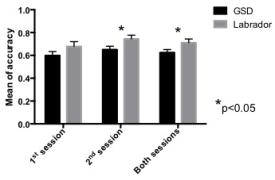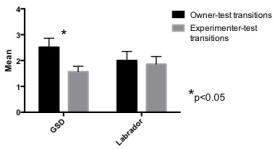
Results & Discussion
Labradors were found to be more active and have higher hair cortisol levels, which corresponds to the breed descriptions. The Labradors performed better than the German Shepherds in both tests: they solved the problem quicker in the problem solving test and they chose more accurately in the pointing test (see figure).

I argue that the lower performances of German Shepherds in the pointing test could be due to their little intrinsic trustfulness in strangers, a known characteristic of the breed, which consequently makes them a good guarding dog breed. The low trustfulness for stranger in German Shepherds is supported by two results: the only breed difference revealed in the C-BARQ questionnaire was a higher stranger aggression score for German Shepherds. Moreover, the German Shepherds had more direct transitions in the problem solving test between their owner and the test setup than between the experimenter and the test setup, while the Labradors transitioned equally between each human and the test setup (see figure).
Correlation analysis showed the latency of choice in the pointing test to be correlated with the intensity of the dog, the hair cortisol levels, with more intense, higher cortisol dogs choosing quicker. But the latency of choice also correlated with the body posture and the duration of physical contact with the experimenter: the dog choosing quicker had a confident body posture and longer physical contacts with the experimenter. The latency of choice was also shown to be lower when the dogs were choosing the correct bucket. Hence, I suggest that the latency of choice is linked to the confidence and trustfulness of the dog: confidence in itself, in its choice and trust in the experimenter.
Generally, I observed a relatively low difference between breeds. I hypothesize that this low difference could be due to the predominance of companion dogs in the study. Again, this seems to be supported by the study indicating recent breed history has more influence than more ancient breed history. We can speculate that breeding for companionship has a stronger influence on individual dogs than the breed (although we cannot rule out the influence of training and life experience, having no genetic analysis coupled with the study). This is also confirmed by the other dog thesis on Labrador types, which found clearer differences between types of one breed bred for different purposes than I did between two breeds.
Responsible for this page:
Director of undergraduate studies Biology
Last updated:
05/06/15
